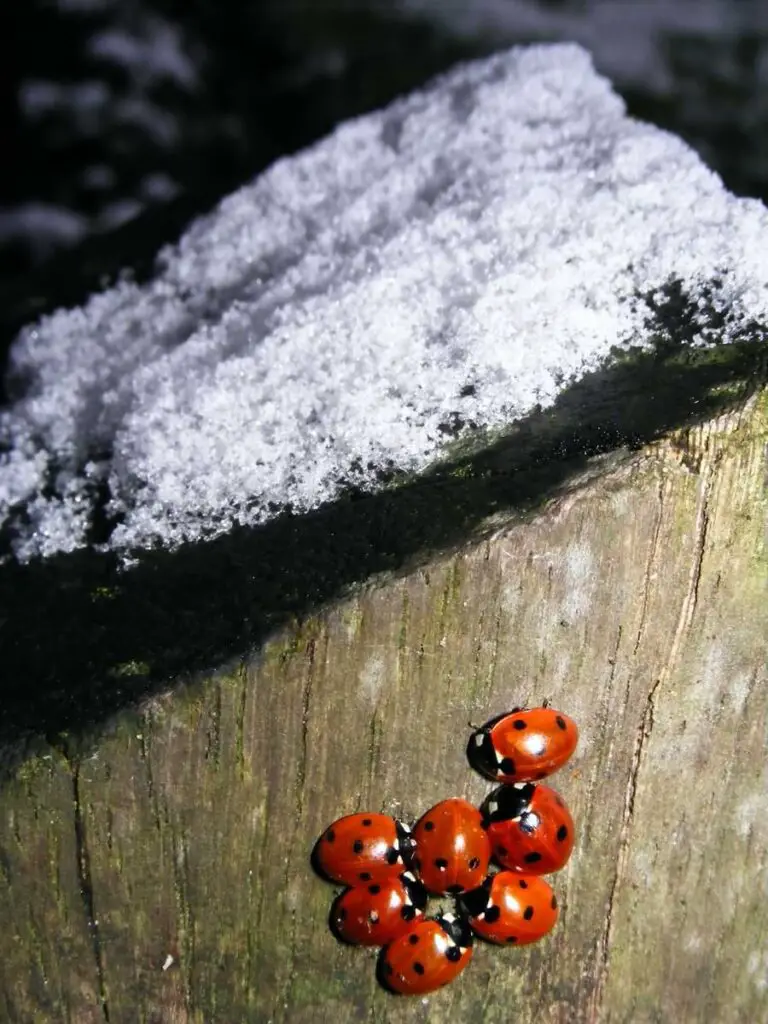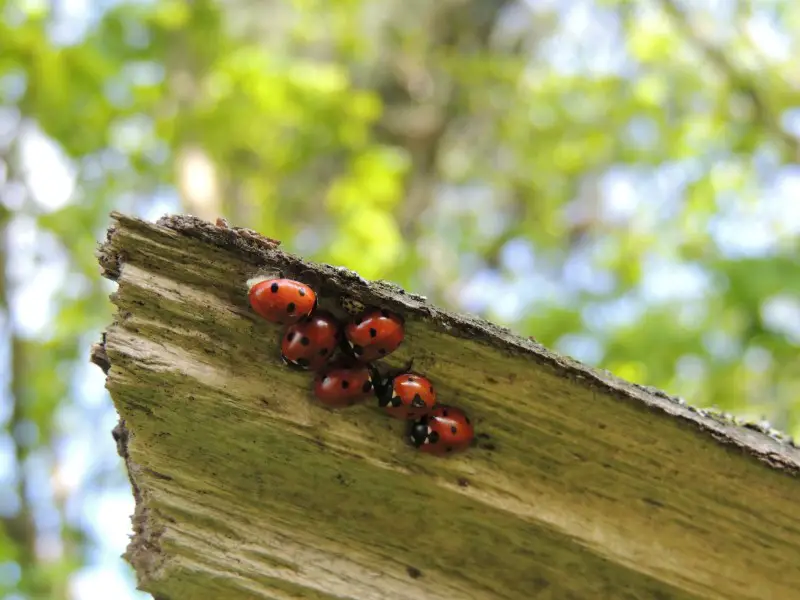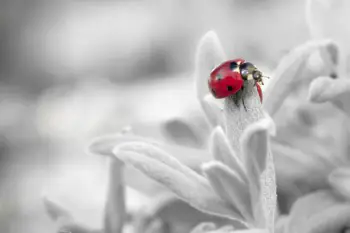So, what do ladybugs do in winter? Ever seen a gathering of Ladybugs who appear to be dormant? Or even just one on their own?
Sometimes they might even seem lifeless so you think they’re dead or dying. Well, that’s not always the case.
I’ve seen lots of these in the past, many of them appear in dark, cool, and possibly moist areas but possibly away from where it’s colder outside.
You may even find them in your house and wonder why they’re attracted to them. Or, if you lift up a rock in the yard for example you may see one or more there too.
I’m going to explore this further and provide some insights for you on what they’re actually doing. Here’s a quick answer first.
The onset of cold weather signals to Ladybugs that it’s time to search for a warmer place to spend the winter. Ladybugs are cold-blooded insects, they need external heat to remain at the right temperature. During this hibernation phase, they’ll often gather in groups to create a warmer environment.
Ladybugs Hibernate in Winter
Another reason why Ladybugs hibernate is simply a lack of available food.
Most of the food resources they would normally hunt – which for the most part is Aphids, have all but disappeared by the time the onset of cold weather arrives, so the only alternative is to wait it out.
Can Ladybugs Survive in Winter?
Absolutely, they are not unique in this sense. Like many insects, Ladybugs too have evolved to survive the Winter months.

Providing the Winter is neither too long nor too harsh. If it’s too long, then their ability to sustain themselves during that time becomes diminished and they could die, or be forced to emerge too early.
If it is too harsh and they do not have sufficient shelter, they may die from the cold.
Often some can be found hibernating under tree bark or in the knots and nooks of trees.
But alternatively, they’re more than happy to find shelter in sheds and garages. Anywhere that fits the criteria.
One perfect place for them is a Ladybug House. Specially designed Ladybug houses can prevent them from entering your house too – and from Amazon this one is perfect!
Where Did All the Ladybugs Go? Ideal Hibernating Conditions
In their normal habitat, they will seek a place to hibernate during the Winter months that suits a number of criteria.
In the wild these places are not that hard to find, but as you can imagine some offer better protection than others.
The warmest places are of course near where humans have heating, see what else attracts them to your house here!
Where Do Ladybugs like to Hibernate?
- Where predators are less likely to reach them
- Away from harsh winds
- Where temperatures remain sufficiently above freezing
- Away from frost-catching areas
- A slightly moist area is ideal
- Under any shelter available to avoid snow cover
- A place least likely to be disturbed
- Where other ladybirds may be present
When Does a Ladybug’s Winter Start? at What Temperature?
This varies depending on both which hemisphere the Ladybugs are in and at what point the onset of cold weather begins.
Ladybugs will avoid anything from the point of zero degrees
In the Northern Hemisphere, you can expect this to be around Mid October onward.
Whilst in the Southern Hemisphere you can expect it from late May or June and onwards till late August or into September.
Why Do Ladybugs Hibernate in Swarms, or Groups
During the Summer months, Ladybugs will emit a pheromone this is primarily to deter predators from eating them, but is also used to attract a suitable mate.

Did You Know…
A Ladybug Group or Swarm is actually called a ‘Loveliness of Ladybugs’
Find out More Interesting Facts About Ladybugs
During winter, if a Ladybug finds what it believes to be a suitable hibernation spot, then it’s believed this same chemical is emitted to attract other Ladybugs to that same spot.
This is why one ladybug can often soon become hundreds – if not thousands, within a matter of hours or days.
The reason for using a pheromone to attract other Ladybugs is, as mentioned early, many Ladybugs nesting in one place offers greater protection against the elements.

Do Ladybugs Eat or Drink Whilst They’re Hibernating?
Whilst Hibernating Ladybugs slow down their metabolism and enter a state of sleep during that period. During this time they sustain themselves by living off fat reserves gained during the summer month.
It is known that Ladybugs prefer to hibernate in moist, almost damp environments. This is so that they can at least take on moisture enough to keep them hydrated.
If Ladybugs are hibernating in your home, where no moisture forms or droplets of water are likely to land nearby, and/or if the heating is higher and constant, it will create a drier environment.
Too dry and the Ladybugs are liable to die from dehydration.

Did You Know…
The growth of a younger Ladybug pauses during the Winter months and resumes in Spring
See more Interesting facts about Ladybugs
When Do Ladybugs Wake up from Hibernation?
Like many insects who hibernate, you can expect Ladybugs to start to become active and emerge from their hibernation areas toward the end of Winter. Then, they’ll likely spend their time seeking out food and regaining their strength before the mating season.
It is after the Mating season and toward the height of summer that you will really start to see many more of them around.
Do Ladybugs Migrate?
Ladybugs can migrate – of sorts, but most strands of Ladybug do not go far. Even though they are capable of great distances.
So you will likely only see them migrating to other more local areas. Some types of ladybugs, in particular the Convergent Lady beetle, often migrate into local mountain regions in Colorado for example.
Generally speaking, they might find an area of land that is less prone to frost or perhaps has better outbuildings they can hibernate in.
However, it should be said that whilst some have pheromone trails laid down by previous generations and do go to the same winter spots.
For the majority of Ladybugs, this travel is not usually any part of an instinctive mechanism to ‘Fly South’ for the Winter.
This generally more limited movement rate is partly the reason why.
Following the introduction of the Asian Lady-Beetle to non-native regions, the pace of invasion within that new area can appear to be fairly slow – by our standards.

Did You Know…
Ladybugs cannot fly when temperatures are below 55°F (13°C))more
See More Interesting Facts About Ladybugs
How to Put Ladybugs into Hibernation Mode
If you are researching Ladybugs further and want to understand how the process of hibernation works for them.
Or, if you are looking to calm Ladybugs down in order to take a closer look or transfer them.
Then you can induce hibernation by emulating the cold quite easily.
Simply put them in a non-metal sealed container (with air holes) and place them in a refrigerator at around 35-40°F (around 2-4°C).
They can remain in the fridge certainly for a couple of days. I’d advise you not to leave them beyond this as a Fridge is not a normal hibernation environment for them to survive in.
Above all – and this probably goes without saying, but do not place them in the freezer.
IF that is the only place you have, then do not leave them in there for more than 20 minutes as this environment is simply too cold and would kill them.
And don’t forget about them!
For me, even though I have put them in the refrigerator before, I’d advise against doing it for more than a few hours. There’s usually no need to cool them down at all.
I’ve never felt the need to do this myself, just buy them at the right time and let them go in the garden at the right point.
Be aware, any mishaps are possible so this should be avoided.

How Long Can Ladybugs Be Refrigerated?
In truth, it’s possible to keep your delivery of Ladybugs in the refrigerator for more than a few days. In fact, you could keep them in there for 2-3 months.
However, beyond two months you should expect there to be a decline in numbers as their food stores run out.
As a rough guide, I’ve created a small table below which should give you a guide on what % of the pack will survive to expect over the length of time for storage.
| Length of Ladybug Storage (35-40°) | % That Survive |
|---|---|
| 1 Month | 95% |
| 2 Months | 90% |
| 3 Months | 75% |
| > 3 Months | 60% – Declining Daily |
I would recommend the following steps when looking after your Ladybugs in the refrigerator
- Ensure the Ladybugs will not be crushed or shaken during storage
- Occasionally moisten inside the bag very lightly with water every 1-2 weeks
- Do not keep them longer than necessary
- Do not forget about them!
- May is the optimum time for release (Northern Hemisphere)
What do ladybugs do in winter – To close
I’ve admired Ladybugs for many years, they’re one of those things about Nature that just have that reassuring cycle to them.
Regardless of what happens, they know what to do and when to do it and they instinctively carry it out – every single year. I’d say a true lesson in the art of stoicism!
I hope you found this article useful, Please be sure to share it.
There’s also plenty more to discover about Ladybugs on my site. You might want to know if Ladybugs Bite! Or my guide on Plants That Ladybugs Love There’s lots to discover.
The kind of things you might want to give to someone special or educational activities for kids. Be sure to check them all out on with Green Kids Crafts.
Didn’t answer your question? Or do you have more?
Check out my Quick Fire FAQ page
Related Questions:
How Long Can Ladybugs Live Without Food? During the summer
Why are there ladybugs in my house in the winter? As the cold winter season approaches, Ladybirds will try to seek out a place with sufficient warmth, away from predators to hibernate.
The release of special pheromones can attract many ladybugs into one place.
So you might soon find your home the subject of a Ladybug Infestation.
To find out how, and why this happened and how to prevent it click here.



My friend sent me a sweet but ridiculous gift of 3000 ladybugs, I live in Paris and do not know what to do with them. Should I find a place for them in the forest outside the city?
Thank you
That’s a pretty unusual gift – but cute! Yes, good call, that would be a good place to put them. Assuming it’s still warm enough for them to find shelter for the winter. I assume you mean like these live ladybugs I normally recommend on Amazon. Great for your flowerbeds!
I have found one lone ladybug wandering around in my bathroom and can only assume it is fixing to huncker down for the winter. Should I set it free outside so it can find other ladybugs to huncker down with or will it be fine doing it’s own thing in my bathroom?
Thanks for the comment. As Winter approaches ladybugs will search for a moist warm place to see the winter through – a bathroom can be ideal for this.
The problem is once they find a great place they emit a pheromone to tell all their buddies they found a great place to spend the winter! So however much you might want to help them, and however hard it may be, it’s always best to take lone ladybugs outside – and wish them well in finding another spot. There are plenty of natural places they can find to enter diapause.
See more in my article “Ladybugs in My House, What to Do About It“. Good Luck 🙂
Hello there! I loved reading and am glad to have found this page! I recently found a ladybug flying around in my hallway a couple nights ago and knew why it was in her, but I’m not confident in my own skills (and my busy schedule) to look after it allll the way till Spring. I kept it in a cup and gave it some honey water today, and have been consistently doing research to see where and how I should release it (that isn’t inside the house) cause I know it will most likely get hurt (and my roommates have heat constantly so that might be too dry of an area for them to hibernate in). I know they seem to love windows and perhaps the layer between the exterior of the house and inside the house? I was going to give it to my campus’ greenhouse, but also thought it was better to let it be in it’s natural habitat. It wasn’t able to fly away considering it was below 50 degrees here (Northeast America, and ty for your fun facts UwU) so I’ve been very hesitant about what to do with it the past few days, and I decided to guide it so it could tuck itself in a little crack in the exterior of the house. It’s the only one there and it’s by the front entrance and near my room, so I hope noises won’t disturb it too much? It crawled into the tight space and stayed there so am I safe to assume that it’s comfortable there? Should I cover the area slightly with some cotton slips so it’s less drafty for the ladybug?
Sorry for long post, I wanted some feedback if I did enough for it and if it’s comfortable for it to survive the long Winter.
Thank you for your time and work! Great read and I enjoyed learning something new today!
Hi Laurel, thank you for the comment and I’m so glad you enjoyed the article. That sounds like the most pampered and helped Ladybug ever! I’d say you found an ideal place for it, so I’m sure it will be fine 🙂 Well done for looking after our lovely creatures!
I have a ladybug hibernating in my house but it is very active last couple of days. It’s still winter so I’m worried it might starve or mistakenly woken up too early. Should I be concerned about its wellbeing?
Hi Mike, thank you for the comment. Ladybugs are pretty bright creatures, and they do stir occasionally during their hibernation period anyway. So I suspect it will decide to go back to “sleep” if it feels the time is not right yet.
Wow, everyone is so accommodating of their ladybugs! I’m certain that I have an infestation and find several every day here in my Montreal area home. I have been flushing them down my toilet, should I just let them be and assume that they will find their way out of the walls in spring? It’s our first year in this house.
Hey Carolyn, thanks for the comments. It’s hard to know what to do with Ladybugs at first, and can be frustrating – as they can make a mess when hibernating! But Ladybugs are important to us, so I have an article for the best method on how to deal with an infestation – and why they’re in your house in the first place! I hope it helps x
So blessed to have found you! I had a feeling they hibernated, but no one I know knows :[. One woke up a bit today and was on my blinds. Then she dropped down to the windowsill under the blinds, and seemingly attached herself to an old dried-up bug. I picked her up and put her in a houseplant. She began digging away, and when I checked on her 5 minutes later she was no where in sight. Do ladybugs ever dig down to hibernate in dirt?
Thank you for helping us lovers-of-ladybugs 🙂 🙂
As an update, he/she keeps I guess flipping over (onto back), but somewhat still moving legs. I am not sure exactly what to make of this, but assume it is not good. 🙁
I think perhaps you might want to see my article on How to tell if a Ladybug is Dead, Dying, or HibernatingHow to tell if a Ladybug is Dead, Dying, or Hibernating.
If I have had ladybugs in a hole punched box all winter in the garage in central NY, and with these 50-60 degree days (and days in the 40’s) but nights in the 30’s, how do you keep them from coming out of hibernation? As I understand it, they can’t survive in NY right now, so I’d worry about them going outdoors. Should I just let them outdoors anyway, so long as it’s above 55 degrees and they could fly to the location of their choice? But, their food source is not available yet either, is it? What to do?
Hi Deb, thank you for the comment, I’m glad you’re caring for them.
The truth is if we weren’t around to give them the shelter they would simply find it elsewhere. You can let then out and I’m sure they will be fine. Try releasing them near some brush or undergrowth, they will soon find a new shelter 🙂